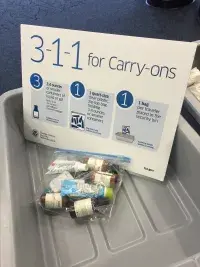 Tubs filled with oversize liquids that have been brought to an airport checkpoint. (TSA photo)
Tubs filled with oversize liquids that have been brought to an airport checkpoint. (TSA photo)
ALLENTOWN, Pa.— Summer travel is in full swing at Lehigh Valley International Airport (ABE) and across the country as more people get vaccinated, grab a low fare to their desired destination and return to air travel.
The Transportation Security Administration (TSA) is prepared to handle the increased checkpoint throughput this summer while staying committed to supporting a healthy and secure environment for airline passengers, TSA employees and airport personnel.
Nationwide TSA officers are screening between 1.8 and 2.1 million people daily, which is a large increase from last year, yet still down significantly from 2019, when closer to 2.5 million people were screened daily during the summer. However, travel volume at Lehigh Valley International Airport has rebounded and is actually exceeding pre-pandemic levels as TSA officers are screening 1,800 passengers per day at the airport.
Airlines flying out of Allentown have several flights scheduled to depart in the same limited two-hour windows from 5 to 7 a.m. and again from 11 a.m. to 1 p.m., when hundreds of travelers are arriving at the airport at the same time to catch their flights. Due to the high volume of travelers during these peak hours, TSA advises travelers to get to the airport well before their flight to ensure that they have enough time for the airline check-in process and for security screening.
“If people had been traveling during the early days of the pandemic, they may have gotten accustomed to arriving a short time before their flight because there were so few passengers, but those days are gone and we recommend that travelers get to the Lehigh Valley airport two hours before their scheduled flights,” said Karen Keys-Turner, the TSA Federal Security Director for the airport.
Individuals who haven’t flown recently, are new to air travel or have previously only flown once or twice a year have started to take leisure flights to visit family, travel to meet friends or take vacations.
“Travelers who are headed out on a vacation typically are not as familiar with security checkpoint protocols, especially when it comes to knowing what is permitted to be carried through a security checkpoint,” Keys-Turner says. “It’s also important to come prepared for security screening. That means knowing what should and should not be packed in a carry-on bag or checked bag. The TSA web site has a lot of helpful information on preparing for a flight.”
TSA offers several ways for travelers to find out if an item is permitted in a carry-on bag, checked bag, either or neither. The TSA web site has a feature on the homepage called “What can I bring?” Type in the name of the item and it will let you know if it should be packed in a checked bag or carry-on bag. The same handy feature is available on the free downloadable MyTSA app. The MyTSA app gives users 24/7 access to the most frequently requested airport security information on any mobile device, including a searchable database that will let you know whether an item can be packed in a carry-on bag, checked bag, either or neither. The app also identifies delay information and current weather conditions at your favorite airports nationwide.
TSA is also active on social media. Travelers can send a question via Twitter to @AskTSA or via Facebook Messenger for live assistance in answering your questions from 8 a.m. to 7 p.m. ET weekdays; 9 a.m. to 7 p.m. on weekends and holidays.
The most common item that travelers bring to the checkpoint that is not permitted through the screening process are oversize containers of liquids, gels and aerosols that are larger than the acceptable limit. Each passenger may carry liquids, gels and aerosols that are 3.4 ounces (100 ml) or smaller through a checkpoint as long as those items fit into a one quart-sized, resealable bag. This is known as the 3-1-1 bag. Common travel items that must comply with the liquids rule include toothpaste, shampoo, conditioner, sun block, mouthwash and lotions. Containers of liquids, gels and aerosols that are larger than 3.4 ounces (100 ml), regardless of the size container, can be transported in checked baggage.
The exception to the 3-1-1 rule is that due to the pandemic, TSA is now allowing travelers to bring one liquid hand sanitizer container up to 12 ounces per passenger in carry-on bags until further notice. Passengers can expect that these containers, which are larger than the standard allowance of 3.4 ounces, will need to be screened separately, which will add some time to their checkpoint experience.
TSA officers also are seeing travelers arrive at the checkpoint with bottles of water, juice, energy drinks, coffee and soda. TSA officers will give travelers the choice to exit the security checkpoint to drink their beverages in the terminal or allow the officer to dispose of it. Travelers may bring empty containers such as a water bottle or insulated flask through checkpoints and fill them on the secure side of the checkpoint.
Leisure travelers may also want to consider enrolling in TSA PreCheck®. Travelers who are TSA PreCheck members travel with ease through a checkpoint. They have no need to remove shoes, belts, liquids, food, electronics or light jackets. Just submit an online application in five minutes and schedule an appointment at any of 380+ enrollment centers. Then come in for a 10-minute in-person appointment that includes fingerprinting for a background check. Receive a Known Traveler Number to enter into a future airline reservation to enjoy faster, more seamless and touchless screening the next time you travel.

